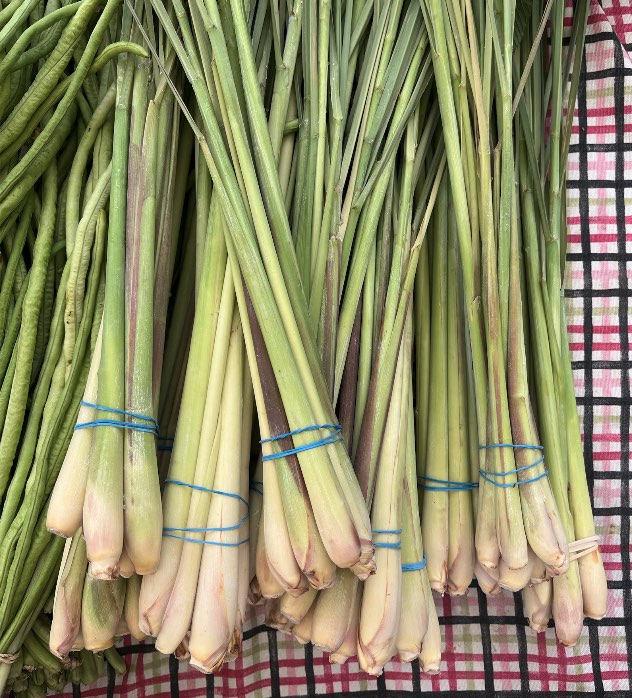
If lemongrass at your grocery store looks sad, you may want to grow it yourself. It's not difficult. It's a grass. It loves sun and during the cold season you can pull it indoors if you cultivate it in a pot.
The trouble that people run into is finding edible lemongrass to grow. For example, at my local nursery -- a dependable spot, I recently saw these plants:

They were labeled "lemon grass" and the plant description said they were botanically Cymbopogon citratus. The label also said the plant was edible. I tore off a piece of the leaf and tasted it. The flavor was mild and somewhat dull compared to the bright citrusy lemongrass that's sold at markets and what I grow.
Was it true lemongrass? Look at those reddish, spindly stalks! The nursery sold a plant that looked like a decorative grass rather than the chubby bulbous stalks sold at the market. This is what a Hmong farmer sells at my weekly farmer's market:

The many kinds of lemongrass
Turns out there are many kinds of lemongrass (Cymbopogon X.) but only two (2!) of them are what is typically used for cooking. According to the University of Wisconsin Horticulture department, there are 55 species in the genus Cymbopogon. However there are two that are interchangeably known as "lemongrass":
- East Indian lemongrass (C. flexuosus, aka cochin or Malabar grass) is a native of India, Sri Lanka, Burma and Thailand.
- West Indian lemongrass (C. citratus) comes from Malaysia and what we mostly use for cooking purposes.
So, West Indian lemongrass is what we're mostly eating.
Then there's citronella grass (C. nardus) -- what provides us with citronella oil for cleaning products, bug repellants, aromatherapy, and soaps. What does citronella grass look like? C. nardus has skinny reddish stalks and according the Singaporean national park's photo below, it looks just like what's being sold at my nursery.

Since I chewed on a piece of C. nardus - bug repellent, I got worrying. Is it edible? No, according to a 2012 article from the India Times and this 2022 information page on C. nardus.
The grass I spotted at the nursery is beautiful but alas, not edible! So the upshot is nursery lemongrass may be mislabeled. And, note that there's a citronella-scented geranium, too.
To be sure, root your own. If you purchase from a nursery, you don't want super thin lemongrass that's got lots of reddish to it. That may be C. nardus, though it's labeled C. citratus.
I hope that the confusion between lemongrass and citronella is not widespread. Southeast Asian cooking is gaining popularity and fresh lemongrass can be hard to find. But, you won't get far with the skinny, inedible stalks of citronella.
How to grow lemongrass to eat
The easiest method is to propagate lemongrass yourself. Buy 3 to 5 firm, fresh looking stalks at a supermarket, farmer's market, or Asian market. What I have in my garden started from trimmed stalks that I bought.
Wherever you shop, choose stalks with the tapered root end intact, not cut off with concentric circles showing. Below is a comparison from my garden (yes to rooting the one on the right). Yes, there are reddish marks on my homegrown lemongrass, but they are not as plentiful as the ones for C. nardus.

If the root end isn't fresh and clean, cut off a bit of it, stick the stalk in jar filled with about 3 inches of water and keep the jar near a sunny window or even outside. Change the water once a week. The stalk(s) will sprout roots. It is August with indoor temps in the mid-70s at my home. One week after being our dinner table floral arrangement, the lemongrass stalk displayed rootlets!

These are akin to baby teeth. Wait another week or so, when the roots are longer -- maybe ¼ to ½ inch, before planting it. At that point, plant it deep enough (about 2 inches should be covered) so the stalk stands on its own. Moderately water lemongrass like you would any other vegetable and it will grow and spread. Be patient. This is what the lemongrass looked like after two weeks:

Here's a video made after 3 weeks of this stalk rooting in water!
Grow lemongrass in a raised bed or pot?
I grow lemongrass in a raised bed because our voracious gophers love lemongrass. If you live where there are snowy winters, put your lemongrass in a pot and bring it inside as the temperatures drop. Thin out the lemongrass when it gets too bushy and gift rooted stalks to others to spread the wealth.
When you harvest lemongrass, always wear long sleeves and gloves. The blades will cut your skin like paper cuts. Use a paring knife to saw at the base of a stalk.

















Celia says
I'm a little confused -- the pictures of lemongrass at your local nursery are listed as Cymbopogon Citratus and you list that as the main kind of the 2 edible types lemongrass we use for cooking, but further down in your writing you mention the lemongrass from the nursery is beautiful, but alas not edible -- am I missing something?
I have the Cymbopogon Citratus variety in a pot outside at home and while it's a bit more spindly than the supermarket, it does taste fully edible unlike the bug repellant variety! I'm curious what specific type of lemongrass you have grown at home or get from the market (scientific names if possible for less confusion haha) so I can also make sure to use them for cooking and growing in the garden in the future!
Andrea Nguyen says
The one at the nursery was mislabeled. Homegrown lemongrass is not as big as what's grown commercially. The one that's rooting is from my garden, for example. What you don't want is lemongrass that has an overly reddish cast to the stalks.
Does that make sense, Celia?
charlie xiong says
where can i get the west indian variety for my big 2 acres garden?
Andrea Nguyen says
I would check with a local nursery. Or, if you know someone who has it, then they can give you some to root -- for free!